Relation Extraction
Automatic Knowledge Base Construction
Denis Savenkov
Emory NLP Group Meeting
February 9, 2015
"Scientia Potentia Est"
- Solving difficult problems requires a lot of knowledge
- Human spend a significant part of their life learning
- Computers need to have this knowledge as well!
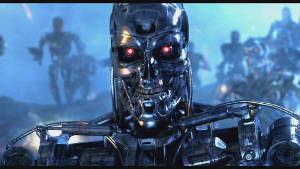
Structured Information
- Most of the information in the world is unstructured:
- text
- images
- video
- ...
- Unstructured information is hard to work with
- We need to add some structure...
Example: Question answering
Who was the PhD advisor of Prof. Jinho Choi?
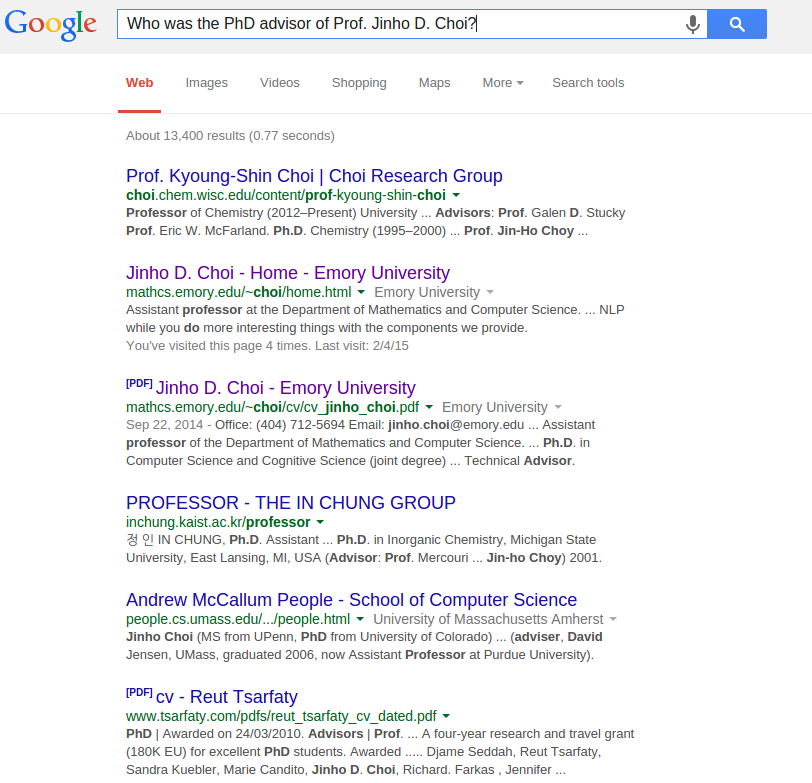
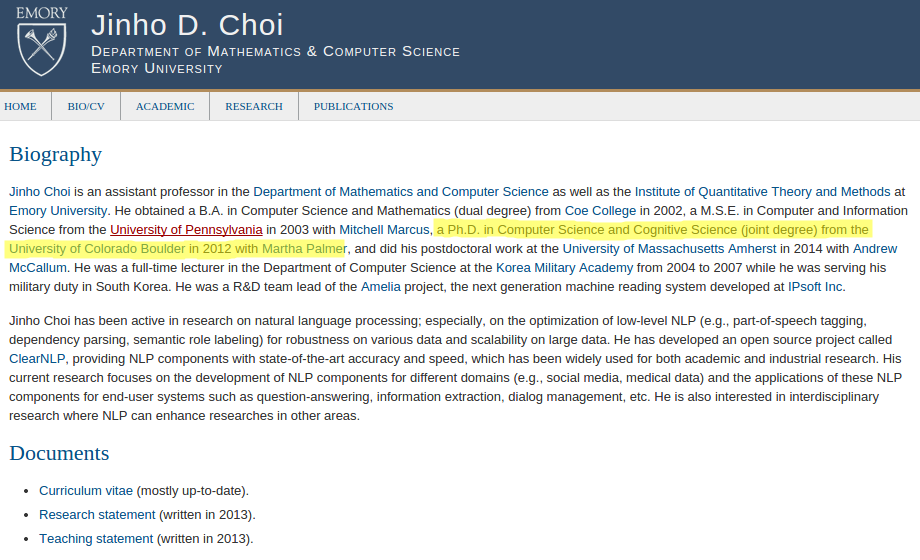
What if we had a database with facts?
We could just query the database and get the answer:
Who was the PhD advisor of Prof. Jinho Choi?
SELECT advisor
FROM phd_advisors
WHERE student = "Jinho D. Choi"
From words to entities

Entities
- We may use different words to refer to the same thing
- Rafa, The King of Clay, Rafael Nadal
- Attributes of entities
- types: e.g. tennis player
- characteristics: e.g. height, weight, birth date
- Some entities are related
- [Tony Nadal] <coach> [Rafael Nadal]

Predicates
- Entities are related in different ways:
- [Tony Nadal] <coach-of> [Rafael Nadal]
- [Tony Nadal] <uncle-of> [Rafael Nadal]
- [Rafael Nadal] <parents> [Sebastián Nadal]
- [Rafael Nadal] <parents> [Ana María Parera]
- Entities with their relations constitute a knowledge base
- We can represent a knowledge base as a graph
Knowledge Base

Knowledge Graphs
 * image from KDD'14 "Constructing and Mining Web-scale Knowledge Graphs" workshop slides
* image from KDD'14 "Constructing and Mining Web-scale Knowledge Graphs" workshop slides
Some challenges
- Validation: knowledge graphs are not always correct
- Interface: how to make it easier to access the knowledge?
- Intelligence: how to create AI fom knowledge graphs?
- Growth: knowledge graphs are incomplete
- link prediction
- ontology matching
- knowledge extraction (this presentation)
from KDD 2014 Tutorial on Constructing and Mining Web-scale Knowledge Graphs, New York, August 24, 2014
Applications
Entity summarization

Applications
Question Answering


- 47M entities and 2.5B facts
- fully structured (entities and relations come from a fixed lexicon rather than free text)
- constructed by community members
- Built by MetaWeb and acquired by Google in 2010
- Data is publicly available
- Will be shut down in 2015 and data transitioned to WikiData
- Tuple: [/m/0jcx, /m/04m8, /m/019xz9] means Albert Einstein was born in Ulm
Incompleteness
71% of people in Freebase have no information on place of birth and 75% have no known nationality *
- Long-tail distribution: we know a lot about popular entities, but there is a heavy tail of less known entities
- How to increase coverage?
- Ask people: crowdsourcing
- Merge with other knowledge bases: ontology matching
- Extract from the available data
* from "Knowledge Vault : A Web-Scale Approach to Probabilistic Knowledge Fusion" by X.Dong et al. 2014
Web of Data
Wrapper Induction
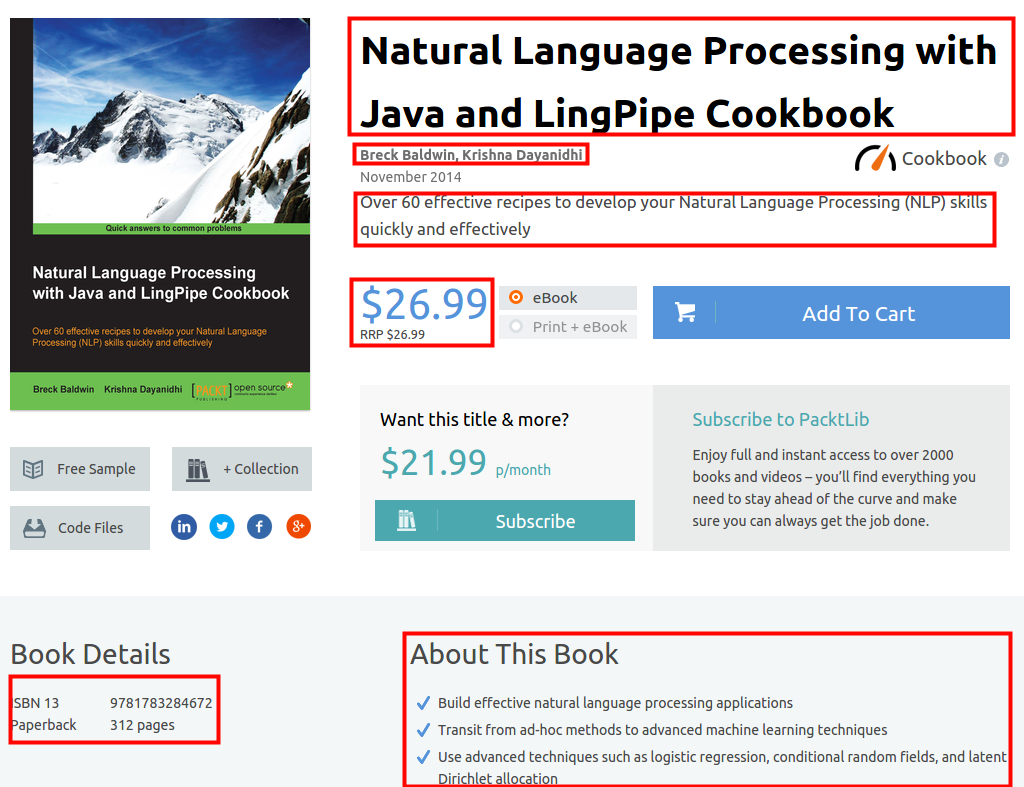 "Wrapper Induction for Information Extraction" by N.Kushmerick et al. 1997
"Wrapper Induction for Information Extraction" by N.Kushmerick et al. 1997
Tables on the web
- Relational data on the web is often represented as tables and it is possible to extract this data (e.g. [1])
 [1] "WebTables: Exploring the Power of Tables on the Web", M.Cafarella et al. 2008
[1] "WebTables: Exploring the Power of Tables on the Web", M.Cafarella et al. 2008
DeepWeb
- Large volumes of data is accessible only through HTML form interfaces
- We can automatically make queries and extract the hidden knowledge e.g. [1]

[1] "Web-Scale Extraction of Structured Data" by M.Cafarella et al. 2008
Relation extraction from text
[Emory College] was founded in [1836] in [Oxford, Georgia] by the [Methodist Episcopal Church].
- Focused extraction: need to find a particular attribute of a particular entity (slot-filling)
- Unfocused extraction: process text and extract everything we can
Focused extraction
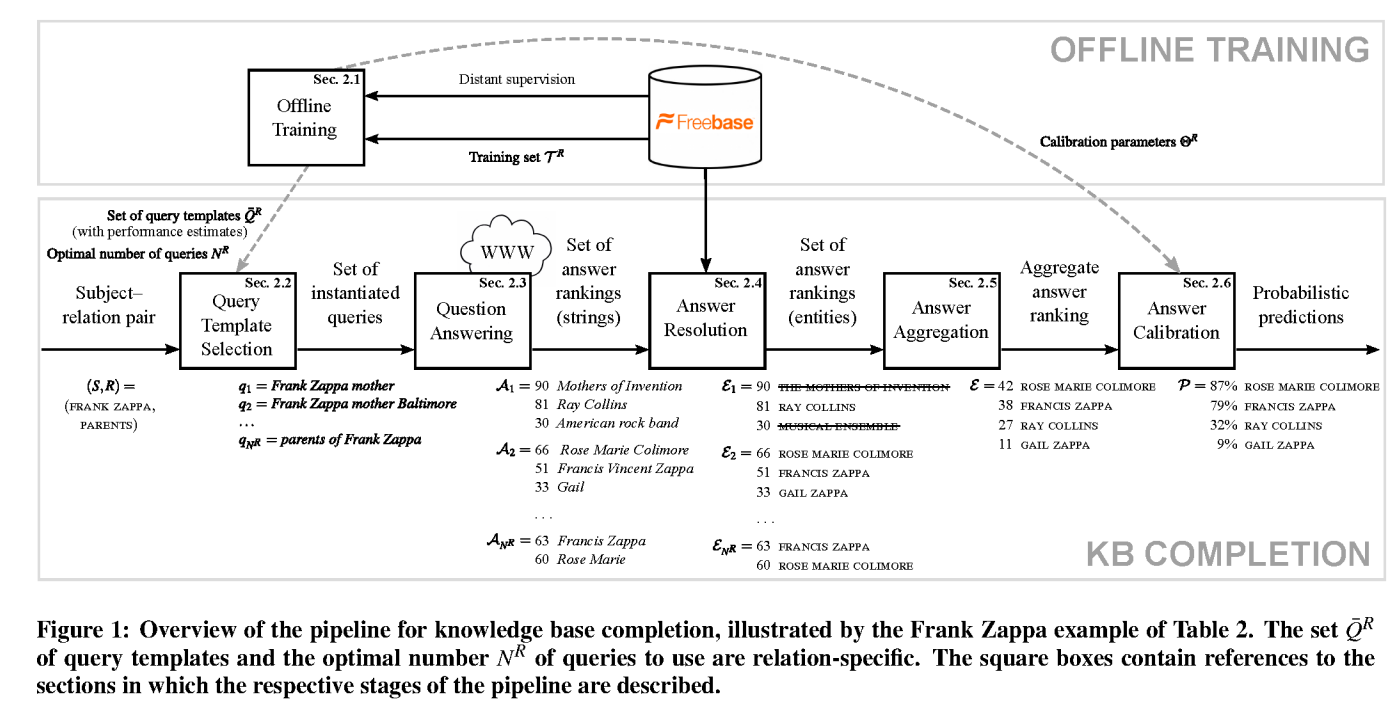 "Knowledge Base Completion via Search-Based Question Answering" by B.West et al 2014 (WWW)
"Knowledge Base Completion via Search-Based Question Answering" by B.West et al 2014 (WWW)
Relation extraction from NL
- Structured extractions (fixed entity/relations lexicon)
- Supervised relation extraction
- Semi-supervised relation extraction
- Distant supervision for relation extraction
- Open information extraction (entities and relations expressed in natural language)
Relation extraction from NL
- Today, computers can't understant natural language text
- How do we teach them to extract knowledge then?
- M.Hearst* proposed to extract hyponyms using simple patterns (Hearst patterns)
- Bruises, wounds, broken bones or other injuries...
- temples, treasuries,and other important civic buildings
- All common-law countries, including Canada and England...
- ...
* "Automatic Acquisition of Hyponyms from Large Text Corpora" by Marti Hearst, 1992
Supervised relation extraction
- Training dataset with sentence-level labels for each relation
- Emory College was founded in 1836 (+)
- Founded in 1836, Emory College ... (+)
- Emory College opened in 1838 (-)
- Datasets: ACE 2004 (Automatic Content Extraction), MUC-7 (Message Understanding Conference), BioNLP challenges
- Solves relation extraction as binary classification problem
- Research studied various features* and training methods
* "Combining Lexical, Syntactic, and Semantic Features with Maximum Entropy Models for Extracting Relations" by N.Kambhatla 2004
Features
- words between entities
- types of entities (person, location, organizaton, etc)
- # of words between entities
- path between entities in a parse tree
- ...
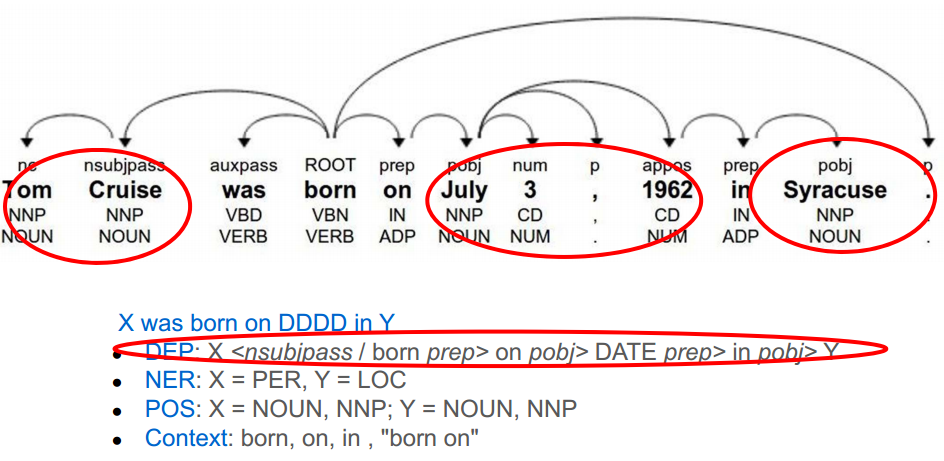
Kernel-based methods
Alternatively, one can define a kernel (think similarity measure) between text fragments and apply kernel-based ML method (e.g. SVM or anything else)
- Parse-tree kernels: similarity of parse trees of 2 text fragments
- Each node can have multiple attributes (word, POS, NER type, etc), which are than used to compute the kernel
- "A shortest path dependency kernel for relation extraction" by R. Bunescu & R. Mooney, 2005
- "Tree Kernel-based Relation Extraction with Context-Sensitive Structured Parse Tree Information" by GuoDong Zhou et al, 2007
Supervised relation extraction
- Cons:
- Expensive to obtain the data!
- Adding new relation requires labelling
- Pros:
- High quality training data
- Explicit negative examples
Semi-supervised relation extraction
- Reduce the amount of supervision required
- Examples: DIPRE, Snowball, KnowItAll
- Based on bootstrapping (iteratively improving the system)
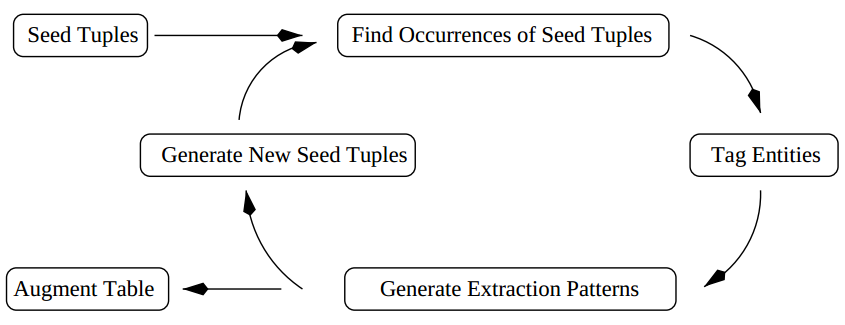 From "Snowball: Extracting Relations from Large Plain-Text Collections" by E.Agichtein & L.Gravano, 2000
From "Snowball: Extracting Relations from Large Plain-Text Collections" by E.Agichtein & L.Gravano, 2000
Semi-supervised relation extraction
- Pros:
- Less supervision required
- Can extract more knowledge triples thanks to bootstrapping
- Cons:
- Semantic drift: as we iterate the system extracts more and more incorrect patterns/triples
- Extending to new relations still requires seed data
Distant supervision
Utilize existing knowledge base to label data and train a model
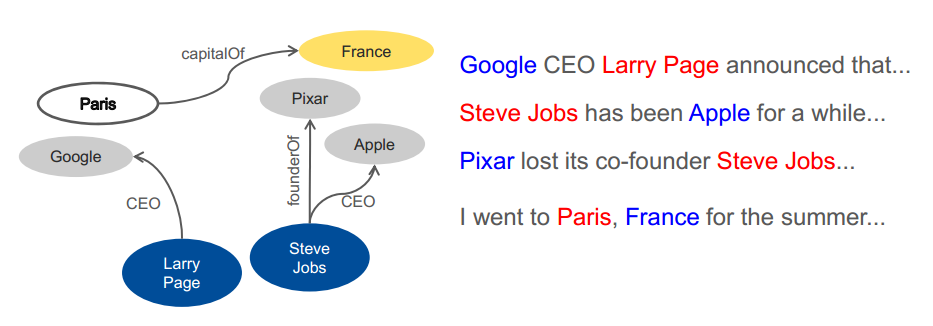 Image from KDD 2014 Tutorial on Constructing and Mining Web-scale Knowledge Graphs, New York, August 24, 2014
Image from KDD 2014 Tutorial on Constructing and Mining Web-scale Knowledge Graphs, New York, August 24, 2014
Distant supervision assumptions
Assume we have a knowledge triple $(e_1, p, e_2)$
- All sentences that mentions $e_1$ and $e_2$ together expresses the predicate p
- At least one sentence that mentions $e_1$ and $e_2$ together expresses the predicate p (multi-instance setting)
- A sentence that mentions $e_1$ and $e_2$ together might express the predicate p and a pair of entities can be related with different predicates (multi-instance multi-label setting)
- "Distant supervision for relation extraction without labeled data" by M.Mintz et al 2009
- "Modeling Relations and Their Mentions without Labeled Text" by S.Riedel et al 2010
- "Multi-instance Multi-label Learning for Relation Extraction" by M.Surdeanu et al 2012
Distant supervision training
- Extract features for all sentences that mention a related pair of entities
- Randomly sample sentences with non-related entities as negative examples
- Train a multiclass classification model

Distant supervision
- Pros:
- Scalable!
- Can be applied in different languages
- Cons:
- Training data is noisy!
- No explicit negative examples
Open Information Extraction
- Introduced in [1]
- Extracts natural language triples from text:
- Apple announced a new iPhone 6. =>
(Apple, announced, iPhone 6)
- Apple announced a new iPhone 6. =>
- Extracts noun phrases as entities and verb phrases as predicates
- A trained classifier is used to predict whether an extraction is good
[1]. "Open Information Extraction from the Web" by M.Banko et al. 2007
Open Information Extraction
- Pros:
- Even more scalable! ($O(N)$ vs $O(N|R|)$)
- Do not require any training data
- Cons:
- Lack of structure: need to cluster predicates
Link prediction
- Some knowledge can be inferred from already acquired knowledge
- [Kyle Korver] plays_for [Atlanta Hawks]
+ [Atlanta Hawks] league [NBA]
= Means that: [Kyle Korver] is [basketball player]
- [Kyle Korver] plays_for [Atlanta Hawks]
- "Random Walk Inference and Learning in A Large Scale Knowledge Base" by N.Lao et al, 2011
- "Logistic Tensor Factorization for Multi-Relational Data" by M.Nickel and B.Tresp, 2013
Never Ending Language Learning
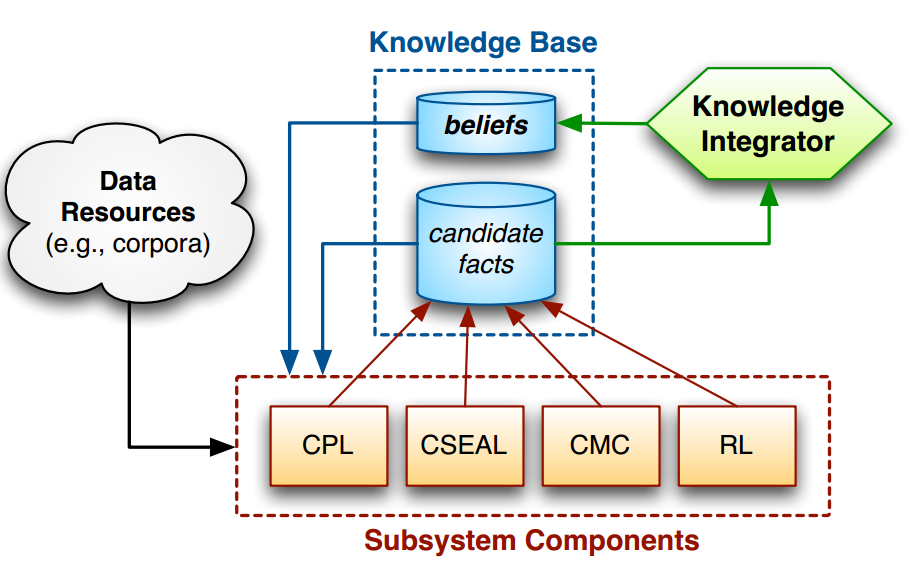 "Toward an Architecture for Never-Ending Language Learning" by A. Carlson et al 2010
"Toward an Architecture for Never-Ending Language Learning" by A. Carlson et al 2010
Google Knowledge Vault
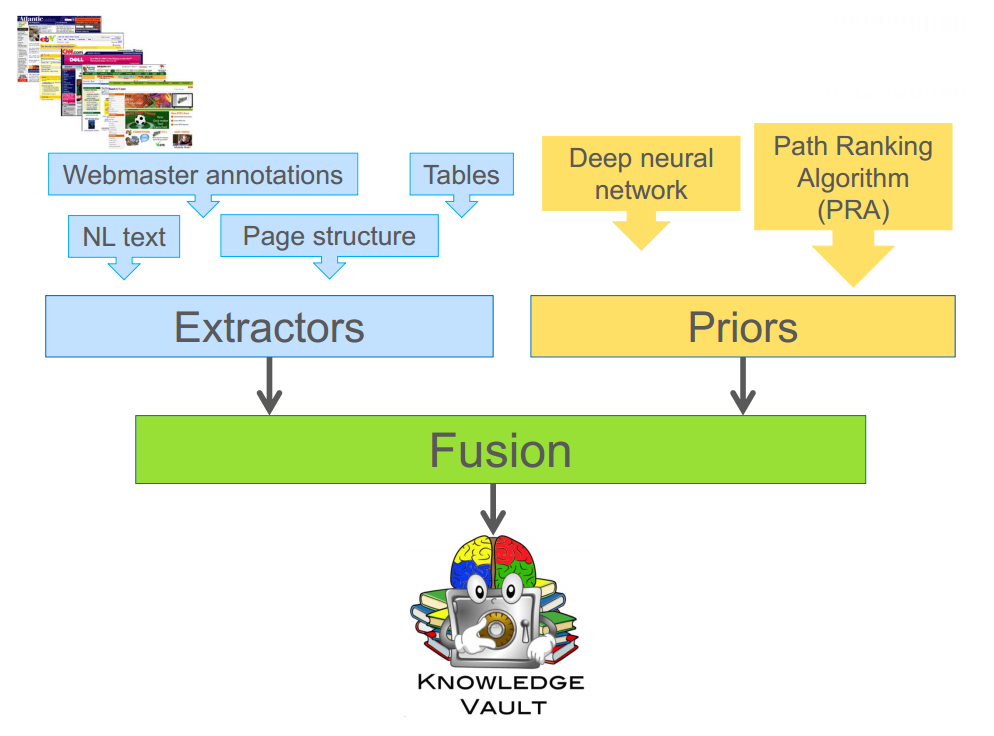 "Knowledge Vault: A Web-Scale Approach to Probabilistic Knowledge Fusion" by X.Dong et al 2014
"Knowledge Vault: A Web-Scale Approach to Probabilistic Knowledge Fusion" by X.Dong et al 2014
Google Knowledge Vault
 from KDD 2014 Tutorial on Constructing and Mining Web-scale Knowledge Graphs, New York, August 24, 2014
from KDD 2014 Tutorial on Constructing and Mining Web-scale Knowledge Graphs, New York, August 24, 2014
Summary
- Computers need data structures
- Knowledge graphs can be used to structure knowledge: entities and relations (RDF graphs)
- Knowledge can be effectively acquired from unstructured data, e.g. natural language text